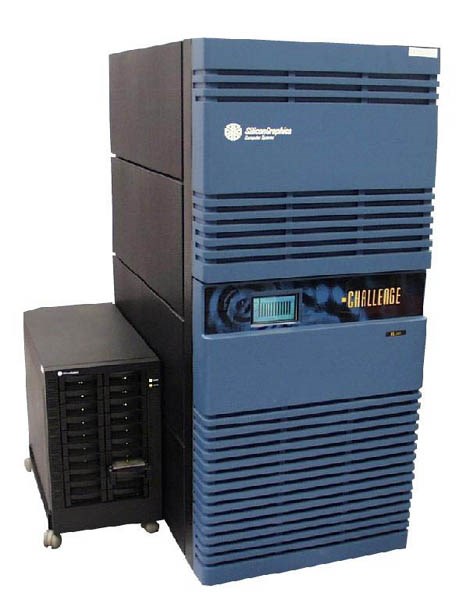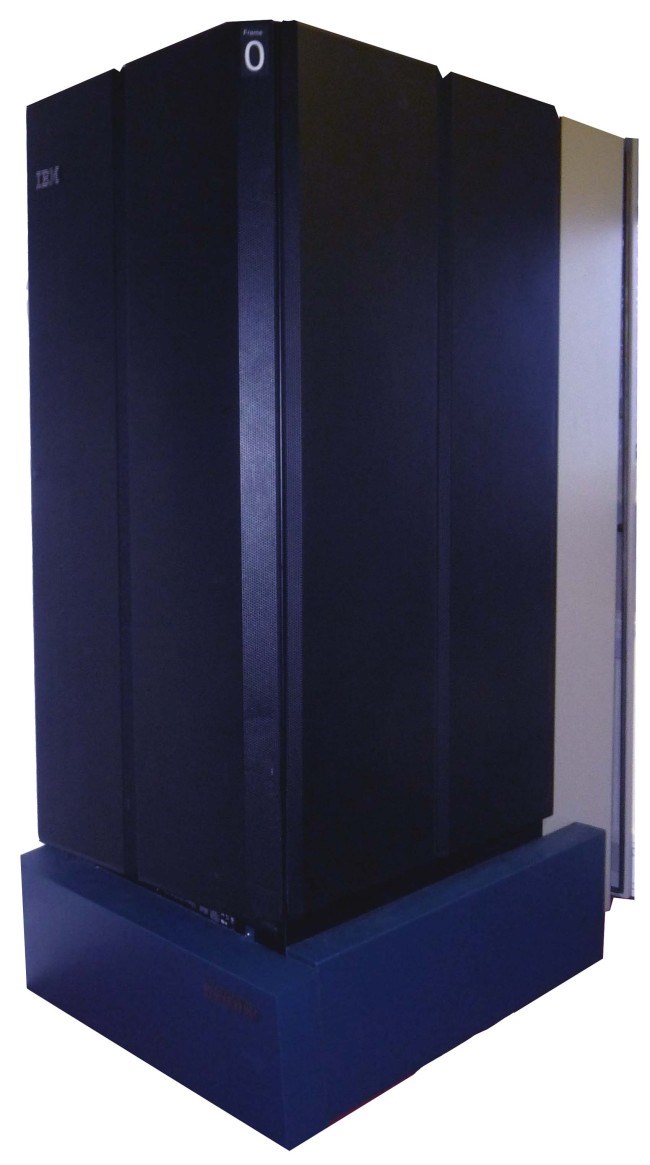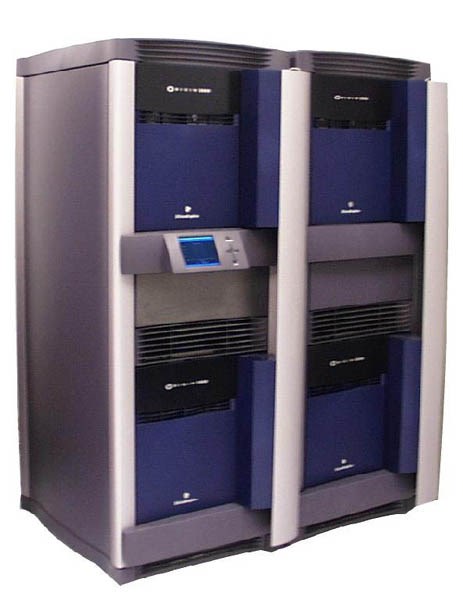History of the high-performance computing environment at Masaryk University (and in the Czech Republic in general) goes back to the mid 1990s, to a project that involved building five independent and interconnected university computing centres. Since 1999 the project MetaCentrum became one of the strategic projects of CESNET association.
Center CERIT-SC is created through the transformation of the Supercomputing Center Brno (SCB) hosted at Institute of Computer Science (ICS, ÚVT in Czech) of Masaryk University (MU).
Supercomputing age
1994 ... SCB was founded. Its creation and initial phase were funded through the Universities Development Fund project “Introducing Supercomputing Technologies at Universities of the Czech Republic“ with a primary aim to make high-performance computing technologies available for a wide community of academic users from Czech universities.
1995 ... Five high-performance computers from SGI and IBM were available at five Czech universities (Masaryk University and University of Technology in Brno, Charles University and Czech Technical University in Prague, and University of West Bohemia in Pilsen)
1996 ... That collaboration with other universities leads to the inception of MetaCentrum as a core of national distributed (super)computing infrastructure in 1996, with Supercomputing Center Brno (SCB) at Masaryk University as the leading partner.
1998-9 ... SCB extended substantially its computing resources through provisioning of SGI Origin 2000 and SGI Onyx two supercomputers. The SGI Origin 2000 (combined later with the Onyx2 system to created a 40 CPU parallel system) represented the most powerful computer installed at Masaryk University (and in fact in the whole Czech academic environment). After 1999, no more funding programs to support supercomputing facilities were available, which created a shortage of funding for supercomputing activities. The only exception was the Program INFRA3, where SCB submitted a project for a National Supercomputing Center; the project was approved but never realized for administrative reasons. Start of 21st century had seen Czech Republic orienting to clusters, composed from de facto standard servers with Intel or AMD processors.

SGI Power Challenge XL with 12 MIPS R10000 processors, the most powerfull computer for the Czech academic community at that time (4.8 GFLOPS), member of the TOP 500 list of the 500 most powerfull computers in the world.

GI SGI Onyx 2 with 8 MIPS R10000 processors (3.2 GFLOPS) and top level graphics subsystem RealityEngine2.

SGI Origin 2000 computer with 32 MIPS R10000 processors and 12.8 GFLOPS was so powerfull that the import licenses were granted only after Czech Republic officialy joined NATO.
Powerful scalar processors were used in all these computers and they covered both main architectural designs: SGI and Digital systems were representatives of SMP (Symmetric Multiprocessing), this means that just a single copy of operating system runs on all processors and the memory is hardware shared among them, while the IBM SP2 computer with a typical representative of DM (Distributed Memory) system, i.e. a system where each processor runs its own copy of operating system and has its own memory (the total computer memory is thus distributed among the individual processors).
Since around 2000, Intel processors became a serious competitor to MIPS, Alpha, and RISC processors, especially when a cost/performance ratio was considered (also, SGI at that time decided to drop the MIPS division and to focus on Intel processors, too). High throughput applications (many single-CPU computations rather than complex multiprocessor programs) start to prevail too. Consequently, SCB started to provide new computing power through cluster based solutions with Intel processors.

Grid age
1999 ... Starts project MetaCentrum, funded as one of strategic projects of the CESNET association, keeping Supercomputing Centre Brno as the primary collaborator. It was conceived with the idea of interconnecting various owners’ resources in order to create an uniform environment for the entire academic community.
2000 ... Significant shift in MetaCentrum technical facilities
- Running distributed cluster among Pilsen (32 CPUs), Prague (32 CPUs) and Brno (96 CPUs)
- Establishment of MetaCentrum portal as the unified informational gateway for all users and administrators of MetaCentrum
- Development of system Perun version I for administration of user accounts
- New batch queueing system PBS Pro
- Research and development activities at the international level
2004 ... Integration of the cluster of National Center of Biomolecular Research at MU.
2006 ... First multiprocessor systems were purchased, using the AMD Opteron processors. These systems represent a return to the SMP machines that dominated the first phase opf SCB existence. The purchase of these systems was funded by MU and its research intent "Large scale distributed and parallel systems".
2008 ... Single sign on – One login and one password access to all machines involved in MetaCentrum
Virtual clusters scheduling – Transition to inter-cluster scheduling architecture in MetaCentrum
2009 ... MetaCentrum has been officially recognized as the National Grid Infrastructure of the Czech Republic with connection to the international environment European Grid Infrastructure (EGI.eu)
HPC cloud compute offers guaranteed computational resources in a secure and isolated environment with standard API access, without the overhead of managing physical servers. The e-infrastructure is publicly funded and provides compute and storage resources to support research and innovation. Its development is driven by requirements of the scientific community.

Cloud age
2011 ... Center CERIT Scientific Cloud (CERIT-SC) was created through transformation of the Supercomputing Center Brno (SCB), as a part of the Institute of Computer Science at Masaryk University (MU). CERIT Scientific Cloud project (reg. no. CZ. 1.05/3.2.00/08.0144, part of the Operational Program Research and Development for Innovations [OP VaVpI in Czech], priority axis 3, subarea 2.3 Information Infrastructure for Research and Development) started the transformation to a research infrastructure CERIT-SC with focus on advances in infrastructure and its flexible use. The project allowed significant upgrade of the equipment operated by the RI to the current state. The center focused more towards the direct collaboration with its users, taking them as research and development partners, not just consumers of the raw computing and storage resources available in the RI.
Center CERIT-SC became an important part of the national e-Infrastructure, a complex system of mutually interconnected networks, computing, and storage resources and corresponding services for the Czech research community. This role of the Centrum CERIT-SC is explicitly mentioned in the Roadmap of Large Infrastructures for Research, Experimental Development and Innovation of the Czech Republic. CERIT-SC resources and services offered and its research targets complement, with emphasis on experimental ("leading edge" and even disruptive) use of the e-infrastructure and focus to research in cooperation with other scientific communities, two other parts of the approved national e-Infrastructure – CESNET and the supercomputing center IT4Innovations.
2012 ... Pilot MetaCloud instalation using OpenNebula was prepared by MetaCentrum and CERIT-SC. MetaCloud is an alternative to the conventional job submission through the batch system. Instead of running jobs in a fixed environment (operating system etc.) defined by MetaCentrum, entire virtual machines are run. The machine is fully controlled by the user. Both pre-defined and user-provided images can be used, Amazon EC2 images are supported too. Two cloud interfaces are available, OpenNebula Sunstone web interface and ONE tools with a command line for advanced users.
Participation in international collaboration to enable HPC-oriented cloud federations EGI Federated Cloud; the IaaS-type cloud made of academic private clouds and virtualised resources and built around open standards. Its development is driven by requirements of the scientific community.
Introduction of the Perun version III covers management of the whole ecosystem around the users’ identities, groups, resources and services. Perun is well suited for managing users within organizations and projects, managing access rights to the services.
2014 ... Intruduction of the new job scheduler (developed in MetaCentrum) supporting (job) planning. The scheduler is able to perform more efficient and safer backfilling the gaps in the schedule, caused by reserving many nodes for largely distributed jobs, and based on the maintained schedule, the new scheduler is able to estimate job’s start time as well as the nodes, which it will run on.
Until 2014, 20 research partners expressed (and in 2015 confirmed) their interest in the RI’s environment and services by signing Memoranda of Understanding agreements.
The need for e-Infrastructures as a prerequisite for progress in virtually all scientific disciplines becames generally accepted in 2010's. The focus shifts from computation to handling scientific data in general, with emphasis on unified approach to the underlying infrastructure. European Open Science Cloud becomes an activity recognised by European Comission to support digital science in Europe

Open Data age
2015.... CERIT-SC gets involved in preparation of a series of implementation projects of European Open Science Cloud.
CERIT-SC staff participates together with CESNET in INDIGO-DataCloud Project developing an open source data and computing platform targeted at scientific communities, deployable on multiple hardware and provisioned over hybrid, private or public, e-infrastructures.
CERIT-SC becomes a partner of several large national and international projects, like ELIXIR, BBMRI, West-Life etc., aiming at coordinated approach in building the computing and data parts of these infrastructures.
CERIT-SC becomes a partner of the Czech national Node of the ELIXIR – an infrastructure uniting Europe’s leading life science organisations in managing, processing, and storing data generated in public-funded research.
2016... OP RDE project proposal CERIT-SC is submitted. The project aims at large-scale innovation of the infrastructure as well as establishing two main infrastructure related research programmes -- High Performance Computing and Big Data
The first cluster with Xeon Phi processors is purchased, extending the CERIT-SC hardware portfolio with MIC (many integrated cores) architecture.
2017... OP RDE project CERIT-SC is approved, starting on May 1.
CERIT-SC passes the interim evaluation of large RI projects.
EOSC-Hub H2020 project starts with CERIT-SC being its full partner.
